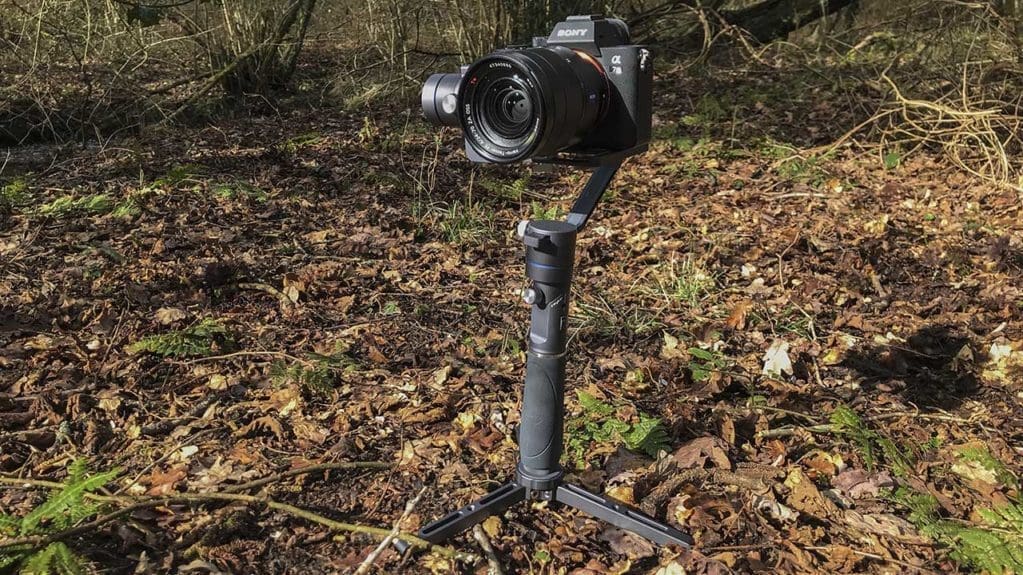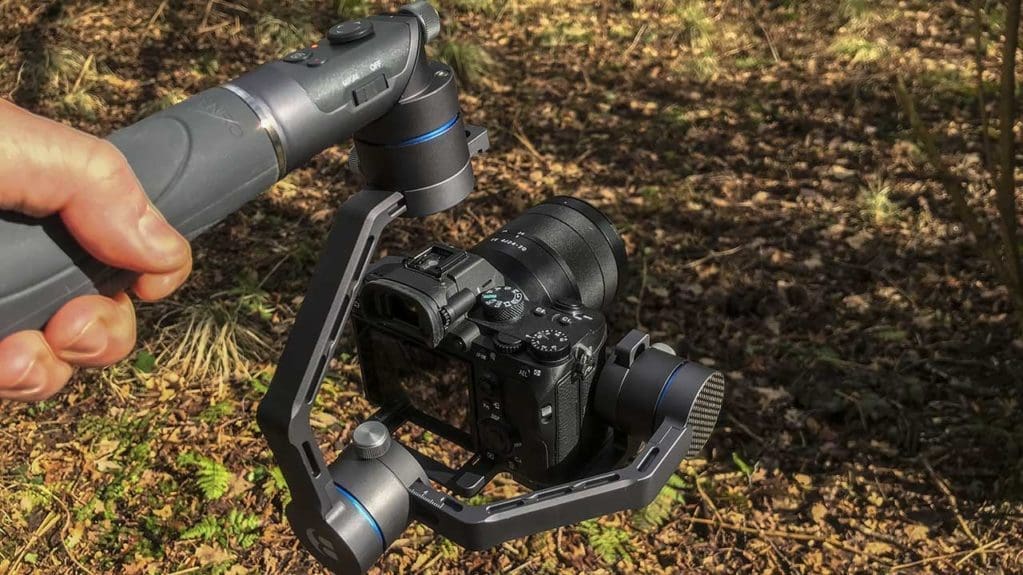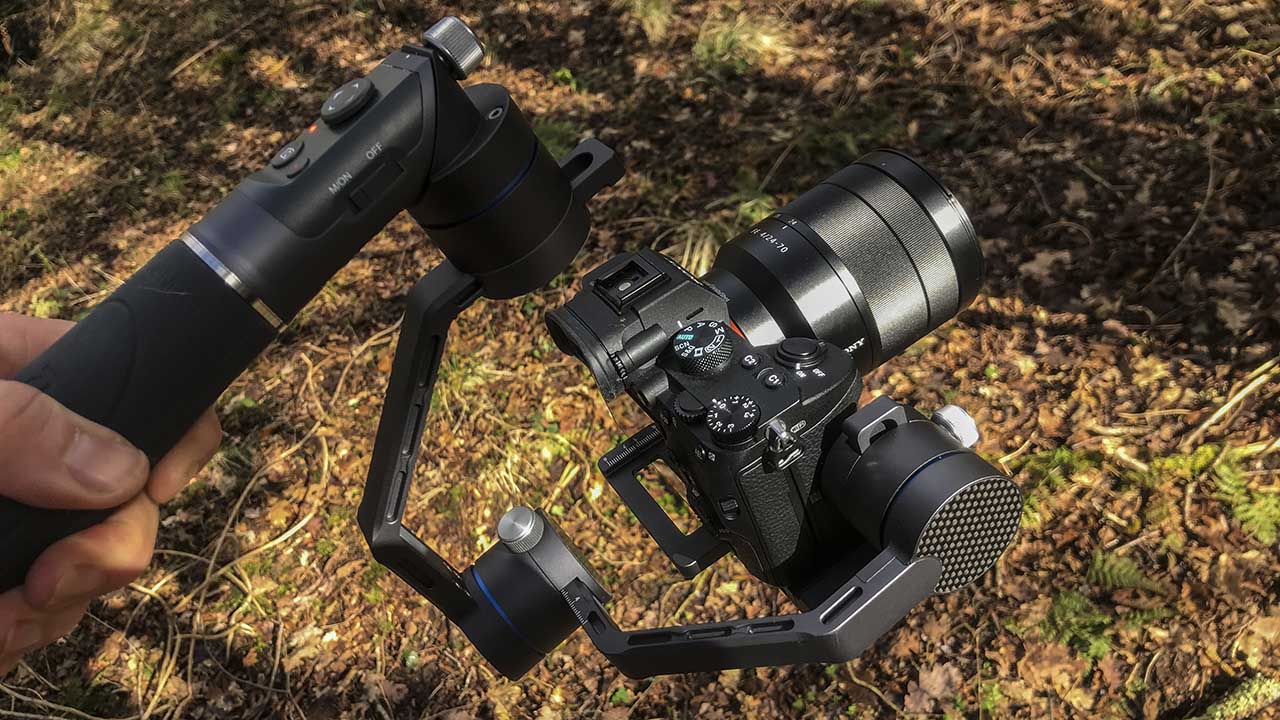Snap Verdict
Being compact and lightweight makes the Benro RedDog R1 an ideal solution for small to medium-sized mirrorless and DSLR cameras.
The motorised gimbal stabiliser’s setup and balance is quick, with the RedDog R1 App, made for iOS and Android devices, enabling fast calibration along with a few other nifty features.
Run time is impressive, lasting an entire days shoot without the need for a re-charge, and unlike some other gimbals, the batteries are swappable if you do find the batteries running flat.
The gimbals payload might be light compared with some of the newer competition, but in use, as long as you give some wiggle space with that max payload, the R1 is relatively forgiving.
If you’re on a budget or need a simple straight for stabiliser the RedDog R1 is an excellent choice.

What is the RedDog R1?
Motorised gimbal stabilisers are coming thick and fast, and with each new generation, there’s a host of impressive new features and additions. However, more often than not all you want is simplicity; something you can grab on set and get filming.
That’s where the RedDog R1 comes in; it’s simple, straight forward and capable of enabling you to capture impressively smooth footage. Now it may be that RedDog R1 was launched almost two years ago, but, the R1 still stands out as one of the best gimbal stabilisers out there for the price.
It strikes a balance between price, performance and features, and while it may not have the design flair of the DJI models or Zhiyun Crane’s, it still has some innovative design features, and it’s a solid performer.
Simplicity isn’t the only thing going for the R1. Many gimbals will struggle with lighter weight cameras such as the Sony a6000. Mounted with these cameras, the RedDog R1 is perfectly suited. What’s more, like those lighter mirrorless cameras the RedDog tips the scales at roughly the same weight as the Ronin RSC2.
Features
The RedDog R1 is exceptionally neat and simple compared with some of its rivals. Adjustments are swift, and getting the camera correctly setup is a relatively quick and simple affair.
Bolt in the baseplate, slide the camera onto the gimbal and find the centre point balance. Then adjust the tilt, roll and pan – the process is the same for all gimbals and like others can take a little time to master.
The RedDog R1, unlike other gimbals, doesn’t boast a huge payload. Instead, it keeps things realistic with a max payload of 1.8kg, that’s more than enough for a Sony A73 with 24-70mm f/4 which weighs in at just over 1kg.
What’s interesting is that the RedDog R1 has a minimum payload of just 150g, something other manufacturers tend to miss out on the spec’s sheet. That’s way below most gimbal stabilisers of this type and means that it’s pretty much compatible with any camera you wish to pop on top, including cameras such as the Canon G1X series.
Powering the RedDog R1 are two Lithium ION batteries which can be replaced for extended usage times. These take three hours to fully charge and provide the gimbal with up to 12 hours of use depending on the weight of the camera and type of usage.
When it comes to the three-axis range, there’s plenty of movement with a tilt of 360º, a roll of 360º and pan of 360º. For it to have this range of movement is rare with gimbals but means that in use you can flip and move the handle as required.
One of the benefits of this range of movement is innovative handle design that can be flipped and rotated ready for low angle shooting.

Build and handling
The Benro RedDog R1 arrives encased in a semi-hard case which is ideal for safely transporting the gimbal. Opening it up and the RedDog R1 is neatly packed inside. It’s a nice looking gimbal, and I’ll overlook the fake carbon adorning the exterior.
The design isn’t as finessed as the DJI Ronin-S, but this gimbal costs considerably less.
Setup is quick once you know what you’re doing, as with any of these gimbals, and then once you’ve run through a quick calibration, you’re ready to go.
There’s little else to the basic function, it just works. The R1 is entry-level gimbal stabiliser, so the motors are designed for Mirrorless and pro-level compacts such as the Canon G1X range. Placed side by side next to the Ronin-S and the differences are obvious; the R1’s is a far lighter weight machine.
Aside from the basic smooth flowing stabilisation, a joystick enables you to control the head’s 3-axis movement. It’s smooth, and a mode button enables you to switch between the different axis locks, which is handy.
In the box is a link cable that enables you to directly plug your camera into the gimbal so you can fire off the shutter from the grip or mobile App.
The accompanying App gives you full control over the gimbal as well as the settings.
Alongside the actual gimbal is a solid mini tripod that bolts to the base and enables you to stand the gimbal while you control it from afar. It also enables you to get better purchase when holding the gimbal in some positions. Again this is a pretty standard feature across most gimbals.
With a quick release of a couple of bolts, you can also change the handle position, from upright, to over the top. This is a huge advantage over the Ronin-S and allows for a much more comfortable carrying position.
The RedDog R1 has weight and size on its side; its compact nature makes it a great option as a lightweight gimbal when travelling and also makes it a lighter weight option over the competition.
Performance
What’s instantly apparent about the RedDog R1 is that the compact size, lightweight construction and ease of use.
Setup is straight forward, taking about three minutes from removing the gimbal from the case to balanced and ready for use. A link cable can then be attached that enables you to control the shutter button from the gimbal handle.
In use, it is apparent that the motors are not as powerful as the likes of the Crane 2S and DJI RSC2, but then this is far cheaper.
As long as you know how to handle a motorised gimbal stabiliser the motors do the job they’re intended to do with precision and reliability.
What I liked about the R1 is that while some gimbals bounce as they reach the edge of their range, the RedDog’s auto range is enough to keep things smooth.
Using a series of cameras and lenses with the RedDog R1 and its limits are apparent, using cameras up to a Sony A73 with 24-70mm f/4 maybe f/2.8 but don’t go much heavier.
Using a camera and lens combo at 1.4kg is close to the load limit and doesn’t allow much of a buffer for the power of the small motors. However, use a Sony A73 with 50mm or Canon G1X and the RedDog R1 stabilises exceptionally well.
As with all stabilisers, it does take practice, and a slight adjustment is walk is required to get perfectly stabilised footage.
The one downside is the position of the roll rear arm. This cuts straight across the rear LCD of all cameras tried, and there’s simply nothing that you can do about it.
However, in use, the lightweight feel of the RedDog R1 comes into its own, the small joystick enables you to take control and glider around corners without too much of an issue. The simple link is also welcome and boosts the feeling of control and completeness of the system.
Through use, you quickly get to learn the RedDog R1’s limits, but overall it’s performance is solid.



